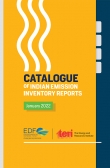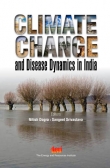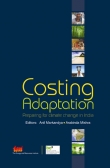Carbon Sequestration by Coastal Floral Community: A ground zero observation on blue carbon
Book Details
As nature-based approaches for the mitigation of climate change are increasingly seen as part of the solution, blue carbon has recently been receiving greater international attention. This has stimulated renewed interest in better management, conservation and restoration of coastal ecosystems including mangrove forests, seagrass meadows, tidal salt marshes, and seaweed beds for the purpose of climate change mitigation. However, a number of gaps still exist in our scientific knowledge on coastal biodiversity, which are critical to developing blue carbon projects for the international carbon market.
Carbon Sequestration by Coastal Floral Community focuses on some of these important issues. Apart from standardizing ecological approach in estimating blue carbon in various vegetation compartments, this book also presents a few important case studies, which serve as the basics of hands-on-scientific training in estimating the magnitude of stored carbon in mangroves, salt marsh, seagrass, seaweeds and phytoplankton. The influence of salinity, nutrients and several relevant hydrological parameters on the rate of blue carbon sequestration has also been critically analysed.
Target Audience
-
Scientist, Researchers, Academicians, Graduates and Undergraduate
Table of Contents
-
1. The Blue Soup of The Planet Earth
1.1 Marine and Estuarine Environment: An Overview
1.2 Physico-Chemical Variables of Coastal Zone
1.3 Biodiversity of The Blue Soup
2. Carbon Dioxide Reservoir in the Planet Earth
2.1 Atmospheric Carbon Dioxide
2.2 Carbon Dioxide Reservoir of the Blue Soup
2.3 Carbon Pool in Coastal Vegetation
A2 Phytoplankton Cell Volume and Diversity in Indian Sundarbans
A2.1 Introduction
A2.2 Materials and Methods
A2.4 Conclusion
3. Mangrove Community
3.1 Overview of Mangroves
3.2 Carbon Sequestration by Mangrove Vegetation
3.3 Carbon Sequestration by Mangrove Soil
4. Seagrass and Saltmarsh Grass Community
4.1 Introduction to Seagrass and Saltmarsh Grass
4.2 Carbon Stock in seagrass and Saltmarsh Grass Community
4.3 Assessment of Carbon Stock in Saltmarsh Grass: A Case Study
A4 Severe Cyclonic Storm “AILA” and Its Impact
A4.1 Introduction
A4.2 Materials and Methods
A4.3 Results and Discussion
A4.4 Acknowledgement
B4 Effect of Saltmarsh Grass (Porteresia Coarctata)Diet on Growth Performance of Tiger Shrimp Penaeus Monodon
B4.1 Introduction
B4.2 Materials and Methods
B4.3 Results and discussion
B4.4 Conclusion
5. Seaweeds of the Coastal Zone
5.1 Overview of Seaweed
5.2 Major Types of Seaweeds
5.3 Carbon Storage by Seaweeds
A5 Key to Common Seaweed Genera and Species
6. Phytoplankton Community
6.1 Introduction to Coastal Phytoplankton
6.2 Phytoplankton Community: A Unique Sink of Carbon
6.3 Triggering Phytoplankton Through Ironfertilization: Looking Beyond Open Ocean
A6 Common Marine and Estuarine Phytoplankton of Indian Sub-continent
B6 Carbon Content in Phytoplankton Community of a Tropical Estuarine System
B6.1 Introduction
B6.2 Materials and Methods
B6.3 Results
B6.4 Discussion
B6.5 Conclusion
7. Molluscan Community: A Unique Carbon Reservoir
7.1 Molluscs of Marine and Estuarine Environment: An Overview
7.2 Composition of Molluscan Shell
7.3 Carbon Stock in Oyster
A7 Studies on Microbial Load in Sea Water, Sediment and Edible Oyster (Saccostrea cucullata) from Indian Sundarbans
A7.1 Introduction
A7.2 Materials and Methods
A7.3 Results and discussion
B7 Heavy Metals in Edible Shellfish Species from the Lower Gangetic Delta
B7.1 Introduction
B7.2 Materials and Methods
B7.3 Results
B7.4 Discussion
B7.5 Conclusion
Keywords
You may also like...
-
 Catalogue of Indian Emission Inventory Reports
Catalogue of Indian Emission Inventory Reports
-
 Innovation for Sustainable Development
Regular Price 655.00
Special Price 590.00
Innovation for Sustainable Development
Regular Price 655.00
Special Price 590.00
-
 Climate Change and Disease Dynamics in India
Regular Price 995.00
Special Price 895.00
Climate Change and Disease Dynamics in India
Regular Price 995.00
Special Price 895.00
-
 Costing Adaptation
Regular Price 995.00
Special Price 896.00
Costing Adaptation
Regular Price 995.00
Special Price 896.00


